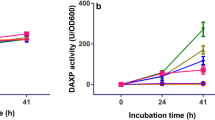Abstract
In typical fermentations at 45‡C on cellulose/corn steep liquor/ammonium and mineral salts medium, growth of the thermophilic fungusTalaromyces emersonii increases rapidly up to about 50 h and then decreases, presumably because of cell lysis, sporulation, or both. The accumulation of cellulase activity follows closely on growth and essentially reaches a maximum at about the same time that cell protein does. By contrast, two peaks of Β-glucosidase activity are observed, one maximal at about 36 h and the second at about 75 h. Fractionation of culture filtrates showed that the cellulase system is comprised of at least four endoglucanases (EC 3.2.1.4), four or five exoglucanases (cello-biohydrolase; EC 3.2.1.91), and three types of Β-glucosidase (cellobiase; EC 3.2.1.21). All are glycoproteins. Indeed, variation in carbohydrate content may account for some of the observed multiplicity of enzyme forms. Although none of the individual components is active against cellulose, reconstitution experiments show that appropriate mixtures of each type act synergistically to effect hydrolysis of substrate. In addition to the three extracellular Β-glucosidases I (Mr, 135,000), II (Mr, 100,000), and III (Mr, 45,700), an intracellular form, IV (Mr, 57,600), has been isolated. All exist as single polypeptides. The extracellular forms I and III are most active at 70‡C, pH 5, and have half-lives under these conditions of 6 and 3 h, respectively. By contrast, the intracellular form (IV) is most active at 35‡C and is rapidly denatured at higher temperatures. Substrate specificity and other studies provide clues to their possible roles in vivo. Β-Glucosidase III acts as an exoglucohydrolase by removing glucose residues from cellooligosaccharides arising from the action of endocellulases. Β-Glucosidase I is the major enzyme involved in cleaving cellobiose and short chain cellooligosaccharides. In doing so it relieves the inhibition by cellobiose of cellulase action.
The intracellular form, Β-glucosidase IV, may have a dual role. By virtue of its transferase activity it may convert incoming cellobiose to the active inducer of cellulase synthesis, whereas by cleaving cellobiose to glucose (hydrolase action) it provides energy for the cell and a repressor of cellulase formation. Four endocellulases have been purified to apparent homogeneity as judged by electrophoresis. Preliminary results show that they all have Mr values of about 70,000 and pI values less than 4. However, they differ from one another in carbohydrate content, thermal stability, and affinity for substrate. The complete cellulase system is most active at pH 4.2, 60–65‡C, and retains about 80% of its original activity after 5 d incubation at 60‡C, pH 5.
Avicel and filter paper most effectively induce synthesis of the complete cellulase system, as measured by the ability of culture filtrate to digest filter paper. Cotton, Solka floc, and α-cellulose are also effective inducers, as are “wastes” such as newspaper, straw, and beet pulp. Little or no cellulase synthesis is evident when lactose, cellobiose, or glucose replaces cellulose in growth media. From a practical viewpoint we find that saccharification of beet pulp is most readily achieved by using enzyme (i.e., culture filtrate) obtained by growing the organism on medium containing beet pulp as the source of cellulose. Of the various strains ofTalaromyces emersonii investigated for cellulase production, we found CBS 814.70 to be the best, yielding approx. 0.5 IU/mL of culture filtrate. By medium optimization and genetic manipulation we have isolated a number of mutants of this strain giving 2 IU/mL or more and enzyme productivities of 20–25 IU/L/h. Xylanase, arabinogalactanase, and pectinase activities have also been detected in culture filtrates of the organism when grown on beet pulp. Various lignocellulosic materials, including cotton, Solka floc, Avicel, filter paper, newspaper, and straw, can be degraded by the enzyme system. However, much of our effort has been directed to investigation of the saccharification of beet pulp since it is available in large quantities at central locations and because its lignin content is low. About 85% of the dry weight of this material is accounted for by cellulose, hemicellulose, and pectin in roughly equal proportions. Culture filtrates effect significant saccharification of pulp as measured by the release of reducing sugars or of glucose. Ball-milling the pulp prior to incubation with enzyme effects considerable improvement in the extent of digestion. Alkali or peracetic acid pretreatment of the ball-milled substrate facilitates enzymic hydrolysis even further. Good results are also obtained when unmilled pulp is (a) pretreated with pectinase prior to incubation with normal culture filtrates or (b) incubated with more concentrated culture filtrates with good pectinase activity. Under suitable conditions, 80% hydrolysis of beet pulp polysaccharides was achieved in 5 d at 60‡C, pH 5.
Similar content being viewed by others
Author information
Authors and Affiliations
Rights and permissions
About this article
Cite this article
Coughlan, M.P., Folan, M.A., Mchale, A. et al. TheTalaromyces emersonii enzyme system. Appl Biochem Biotechnol 9, 331–332 (1984). https://doi.org/10.1007/BF02798961
Issue Date:
DOI: https://doi.org/10.1007/BF02798961




